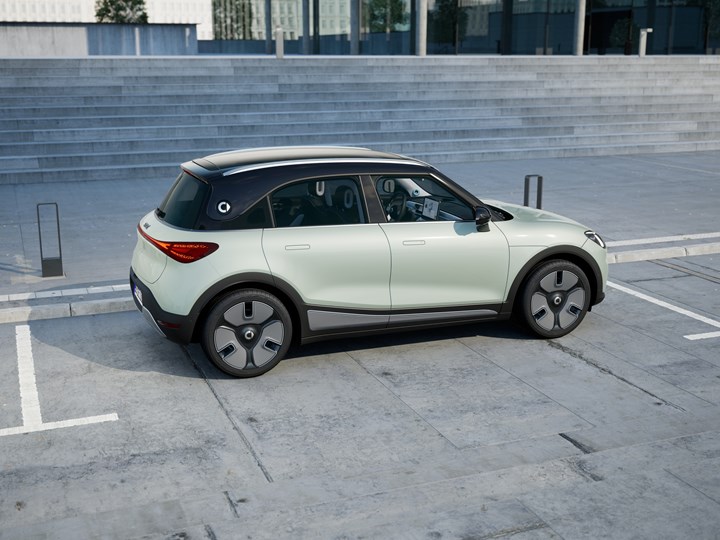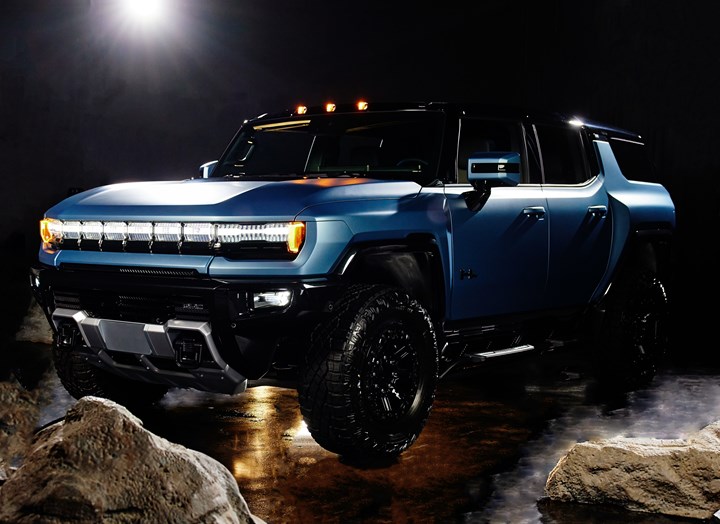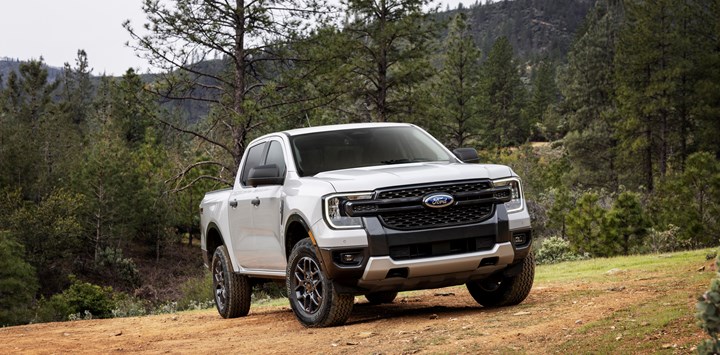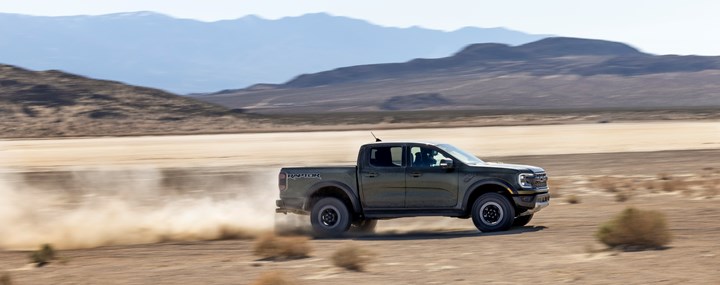on AV racing, mobility stats, still smart, HUMMER EV, & the '24 Ford Ranger
Racing without drivers. . .getting from here to there. . .remembering smart. . .HUMMER EV even more limited. . .Ford’s new Ranger. . .
Racing and the Algorithm

Developing the algorithms that provide autonomous operation of the race cars is both an educational exercise as well as a competitive challenge for the students who participate. (Image: IAC)
Continental recently held a “take your children to work day” program at its North American headquarters in Auburn Hills, Michigan.
The company had announced it was becoming a partner in the Indy Autonomous Challenge (IAC). So there was a Dallara AV-21 in the lobby of the building.
One of the event’s organizers thought that that would be ideal for the kids. Perhaps a chance for them to get into a full-size race car.
But then someone pointed out that there is no driver’s seat or steering wheel or any other human-centric features of the Dallara model which, in its non-autonomous configuration, runs in the Indy Lights series.
With drivers. Something the IAC doesn’t use.
\\
Continental is supplying the IAC series with its ARS540 4D imaging radar.
This is a sensor that is a production product, not a special race unit. It is currently available in the BMW iX electric SUV.
Vinh H. Tran, who is the head of Conti’s Autonomous Mobility business in the Americas, says the ARS540 will be launching in a North American premium vehicle next year.
(4D? It measures range, Doppler, azimuth, and elevation, each directly and independently. Which means? Accurate detection of objects at up to 300 meters.)
\\
Paul Mitchell is president and CEO of Energy Systems Network (ESN), which manages IAC, and he heads IAC.
There are 10 race cars. Each car, he says, is exactly the same. It is essentially a spec series.
But whereas in a racing spec series a lot is riding on the skills and talents of the individual drivers, in the IAC the team members are the ones that make all the difference.
And those teams hail from places including Technische Universität München, University of Wisconsin-Madison, University of California-Berkeley, Korea Advanced Institute of Science and Technology, and Politecnico di Milano.
Teams of engineering students.
Mitchell says ideas behind IAC include addressing edge-case scenarios for autonomous technology, engaging the best and brightest student minds to create innovations in the space, and making the public aware of what autonomous technology can do (e.g., if it works at high speeds at the Indianapolis Motor Speedway, someone is going to feel far more comfortable cruising in AV mode at 35 mph on Main Street).
\\
It's about the algorithm.
That’s what makes the difference between finishing first and not.
As each of the teams has the same equipment as all of the others—from the dSPACE AUTERA computer to the Bridgestone tires—the way they orchestrate the inputs from the sensors and control the actuators such as steering, brakes and throttle through the algorithms they develop is the key to success.
\\
Tran says a large part of Conti’s support of IAC goes to its support of science, technology, engineering, and math (STEM) education for young people. He explains that by giving the students access to the ARS540 it provides them with familiarity with the technology.
And it isn’t a matter of Conti just shipping a box of radar units to the IAC garage for installation.
Conti has established what Tran refers to as “office hours.” During these periods the students can contact Conti engineers for whatever questions they may have about the 4D radar.
Ideally, the exchange is beneficial to both sides: the students get a better understanding of the gear; the Conti engineers get some feedback that they may otherwise not have considered.
\\
The races that the IAC has run to this point aren’t races as you might think of them.
Initially it was a car at a time running for the fast laps. Just one car on the track. Then another. And another. And. . . .
Then, Mitchell says, it includes an arrangement where there is a lead/follow/pass/repeat. The pair of cars go in that pattern at set speeds until one of the cars can’t execute the pass.
All of the races have been on ovals.
Next month IAC is going to Italy where the cars will compete at the Monza Formula 1 circuit.
While running autonomous vehicles on a road course might seem to be more challenging than an oval, Mitchell says that’s not really the case. On an oval there are plenty of potential places to pass; on a road course those sections are limited.
However, the Conti radar units won’t be installed by the time of the Monza race.
When the cars return from Europe the integration will occur.
Mitchell says IAC will be going back to Monza next year, too.
By then the racing may be more like, well, racing.
///
Getting from A to B without a C (Car)
Although it seems that moving into the future transportation will be all about electric crossovers, trucks and a few cars for good measure, according to a global survey conducted by the McKinsey Center for Future Mobility, people are going to be getting from here to there more often in other modes.
These numbers are a comparison between 2022 (the first number) and 2035.
Traditional public transport
- 23%
- 26%
Private car
- 45%
- 29%
Micromobility
- 16%
- 19%
Ride hailing & taxi
- 2%
- 4%
Walking
- 14%
- 14%
New forms (e.g., robotaxis)
- 1%
- 8%
As you can see, the only category with a decline is Private car.
According to the McKinsey researchers, “Car sales will likely rise globally over the next few years and peak by the end of this decade. They could then fall to 84 million units by 2035, down from the 85 million units sold in 2015.”
While you might think a one-million decline is not particularly a big decline, realize that in 2022 the global population was 8 billion and it is expected to be on the order of 8.9 billion by 2035. Wouldn’t there be a need for more cars, not fewer?
What’s more, the McKinsey researchers estimate that in 2035 car sales in the European Union are forecast to be 20% lower than 2015.
In the U.S. things are worse: a potential decline in car sales of 30%.
///
Something About smart

Although smart has undergone plenty of changes over the years, the quirkiness that led it to start the name of its company without an initial capital letter remains, as this new EV from the brand is the “smart #1 Premium.” Yes, plenty of brands use numbers in names, but the hashtag is an interesting approach. (Image: smart)
Back before the Apple Watch adorned so many wrists, Swatch watches were quite a phenomenon. They had style. Simplicity. Standard global pricing. There were rapid model developments and changes. Not only did they challenge the traditional Swiss watch industry (and they were Swiss watches), but even the Japanese watch manufacturers.
Nicolas Hayek, who ran SMH, the company that produced Swatches, started thinking about getting into the car business in the 1980s. And by March 1994 SMH and Mercedes announced Micro Compact Car AG (MCC), of which Mercedes held 51%.
MCC built a factory in France—Smartville--that had an innovative approach to assembly, which included deep collaboration with suppliers, who developed modules that were put together in the plant.
As time went on, SMH’s stake in the company shank to 0.
While the smart cars were cute and clever, they were also small. Certainly not the sort of thing that found much appeal in the U.S., and even in Europe the smart fortwo and its kin found underwhelming acceptance. Better than in the U.S. But still. . . .
Mercedes continued on on its own until in 2019 when a joint venture with Chinese automaker Geely was announced.
And Now. . .
smart Automobile Co., Ltd., as the company now exists, has a strategy named “China-Europe dual-home.”
Its plan is to produce only EVs.
And its plan has it concentrating on markets including China, Europe and southeast Asia.
The U.S. seems to be a place where the new smarts won’t be.
The first new smart is called smart #1. Although it was launched in China last fall, it won’t be making it to the U.K. until later this summer.*
So as you’re not likely to see one here in the U.S., here’s some stats about the smart #1.
There are three trims: Pro+, Premium and Brabus.
The first two both have a single 200-kW (268-hp) motor and RWD, while the Brabus has dual motor for 315 kW (422 hp) and AWD. All the cars have a 32-kWh lithium-ion battery (NMC), and all can be charged from 10 to 80% on a DC fast charger (150 kW) in less than 30 minutes.
The range (WLTP schedule—this is, after all, the U.K.) is 260 miles for the Pro+, 273 miles for Premium and 248 miles for Brabus (of course, that car has a 0 to 62 mph rate of 3.9 seconds while it is 6.7 seconds for the other two).
Dimensionally, these vehicles are small:
- Length: 168 inches (Brabus: 169)
- Width: 72 inches
- Height: 64 inches
- Wheelbase: 108 inches
But one thing these vehicles, built in China, aren’t, and that’s inexpensive.
Starting prices are:
- Pro+: £35,950
- Premium: £38,950
- Brabus: £43,450
==
*Recent stats from the U.K.’s Society of Motor Manufacturers and Traders have it that the most popular cars on the road in the U.K. are superminis and small family models, accounting for nearly 60% of all cars in service. So presumably there is a willing market there for the vehicle. And as for why smart #1 probably won’t come to the U.S. market: according to Ford, in 2022 there was one F-Series sold every 49 seconds in the U.S. (See below for more on Ford pickups.)
///
HUMMER EV: Limited Edition

GMC 2024 Hummer EV Omega Edition: the HUMMER EV is still so comparatively rare, all models are special editions. (Image: GMC)
Stipulated: the GMC 2024 HUMMER EV Omega Edition is a good-looking electric behemoth, especially given that Neptune Blue Matte exterior paint color.
But there is something that needs to be taken into account.
GMC says this is “an exclusive special edition.” And that it is “a limited-edition vehicle.”
- In Q1 2023 GMC delivered two HUMMER EV pickups.
- In all of 2022 it delivered 854 HUMMER EV pickups.
Seems like everyone who has gotten one has a special, limited-edition vehicle.
Just lacking that very attractive paint.
///
2024 Ford Ranger: Because Not Everyone Needs a Big Truck

2024 Ford Ranger XLT. Sold around the world. Styled with the North American market in mind. (Image: Ford)
Although the pickup truck market in the U.S. is absolutely enormous (as are, let’s face it, most of the trucks in that category), pickups are also in demand in other parts of the world, although perhaps not those with a 164.1-inch wheelbase.
So it isn’t entirely surprising to learn from Nima Nourian, external design manager for the 2024 Ford Ranger midsize pickup, that the styling for the vehicle was executed at the Ford design studio in Melbourne, Australia*, as was the current model.
But it is somewhat surprising in that the ’24 Ranger, compared with the current model, looks, especially from the front, far more robust—more like a full-size.
Nourian explains that the current model was designed for the rest of the world and brought to North America while the design for the new one was designed for North America and is going out to the rest of the world. (This focus is completely understandable given that the Ford F-Series has been the best-selling truck in the U.S. for 46 years running and the best-selling vehicle for 41 years.)
Capable
And Juan DePena, vehicle chief engineer for the ’24 Ranger, says it is a bit bigger than the model it replaces—the wheelbase for the new one is 128.7 inches compared with 126.8 for the outgoing. Far, of course, from the full-size. The track width for the ’24 is also wider: 63.8 inches v. 61.4 inches.
DePena notes that because this is a Ford truck they did extensive testing of the vehicle—physically on five continents, 10 countries; virtually on Ford computers.
The demanding testing is also predicated on the fact that the new Ranger uses the fully boxed, high-strength steel frame that underpins the Bronco. (Both vehicles are being built at the Michigan Assembly Plant in Wayne, Michigan.)
Because this is a truck, it is engineered to do things like tow—it can handle up to 7,500 pounds—and haul stuff in the 59.6-inch long bed—available payload capacity of 1,805 pounds. (DePena points out that, yes, you can put a sheet of plywood between the wheelhouses, as the distance between them is 48.2 inches.)
Digital
Because this is 2023 and it is expected, it is equipped with tech, such as a standard 8-inch digital instrument cluster or the optional 12.4-inch version, and a standard 10.1-inch center touchscreen or the optional 12-inch screen. There is Ford SYNC 4A onboard, as well as a standard embedded 4G LTE modem.
There are the available driver-assist features like a blind-spot warning system that can even accommodate trailers. Speaking of trailers, there are also Pro Trailer Backup Assist and Trailer Reverse Guidance, systems that use cameras to help coach the driver on what to do in order to get that boat or trailer on the hitch to go in the intended direction.
The standard powertrain is a carryover from the current model: an all-aluminum 2.3-liter EcoBoost I-4 that produces 270 hp and 310 lb-ft of torque. There is an optional 2.7-liter EcoBoost V6 that provides 315 hp and 400 lb-ft of torque. Both powertrains are mated to a 10-speed automatic.
That’s the standard 2024 Ranger.
And Then There’s This

Because sometimes your run to Home Depot involves going where roads aren’t: Ranger Raptor. (Image: Ford)
But there is another variant. The Ranger Raptor. About which Carl Widmann, Ford Performance chief engineer, says, “This is the baddest Ranger we’ve ever made.”
- Twin-turbo 3.0-liter EcoBoost V6. Graphite iron block. 405 hp. 430 lb-ft of torque.
- Four wheel drive system with electronically controlled on-demand two-speed transfer case and front and rear locking differentials.
- Aluminum upper and lower control arms. Long-travel rear suspension with a Watts linkage and trailing arms.
- FOX 2.5-inch Live Valve Internal Bypass shocks.
- Reinforced front frame rails, front shock towers, rear shock brackets, and suspension mounting points
- High-strength steel front bash plate.
- Engine, transfer case and fuel-tank shields.
Widmann: “It’s right-sized for tight trails and daily life, can carry lots of gear, and”—this is what it is really about—“is a blast to drive flat out.”
==
*According to the Australian Federal Chamber of Automotive Industries, in 2022 the Ford Ranger had the second highest sales of any model sold in the country. First place went to the Toyota Hilux. . .a pickup truck.
]]]
RELATED CONTENT
-
on lots of electric trucks. . .Grand Highlander. . .atomically analyzing additive. . .geometric designs. . .Dodge Hornet. . .
EVs slowdown. . .Ram’s latest in electricity. . .the Grand Highlander is. . .additive at the atomic level. . .advanced—and retro—designs. . .the Dodge Hornet. . .Rimac in reverse. . .
-
The Koenigsegg Jesko Has An Amazing Engine
It is hard to believe that this is a vehicle in “serial” production with such extraordinary powertrain performance
-
Plastics: The Tortoise and the Hare
Plastic may not be in the news as much as some automotive materials these days, but its gram-by-gram assimilation could accelerate dramatically.


.jpg;width=70;height=70;mode=crop)






